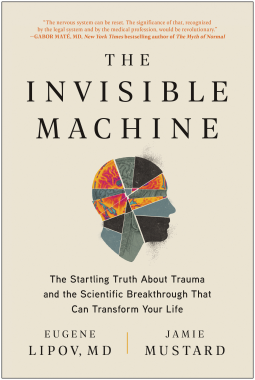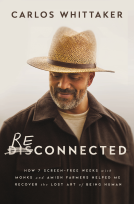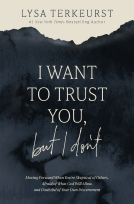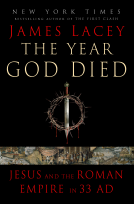
The Invisible Machine
The Startling Truth About Trauma and the Scientific Breakthrough That Can Transform Your Life
by Eugene Lipov, MD; Jamie Mustard
This title was previously available on NetGalley and is now archived.
Send NetGalley books directly to your Kindle or Kindle app
1
To read on a Kindle or Kindle app, please add kindle@netgalley.com as an approved email address to receive files in your Amazon account. Click here for step-by-step instructions.
2
Also find your Kindle email address within your Amazon account, and enter it here.
Pub Date Apr 11 2023 | Archive Date Jul 03 2023
Talking about this book? Use #TheInvisibleMachine #NetGalley. More hashtag tips!
Description
The world has long misunderstood trauma. Now, leading experts in the field have a radical new understanding of post-traumatic stress . . . and a surprising new treatment to reverse it could have profound implications for medicine, mental health, and society.
Despite its prevalence, post-traumatic stress, PTSD, is often seen as an unbeatable lifelong mental disorder. However, top trauma doctors and neuroscientists now understand that the result of trauma is not a disorder, but rather a physical injury—and while invisible to the naked eye, the posttraumatic stress injury (PTSI) can now be seen on a scan. Most importantly, the effects of PTSI are reversible.
Meet Dr. Eugene Lipov. His research and partnerships have led to an amazing discovery that all trauma has at its root a single piece of human hardware: the sympathetic nervous system, controlling the fight-or-flight response. Anyone who has endured trauma, including long-term microdoses of emotional stress, can have this injury. Dr. Lipov has pioneered a safe, 15-minute procedure that reverses the injury, relieving mild to extreme symptoms of PTSI—irritability, hypervigilance, anxiety, insomnia, and more—for survivors to combat soldiers to the everyday person.
Weaving hard science with moving human stories, The Invisible Machine reveals how this treatment was developed. It also tells the incredible story of the unlikely team, including the doctor, an artist, Special Forces leadership, and a sheriff, who are working together to change our understanding of post-traumatic stress and why it matters to society.
Coauthored by artist and innovator Jamie Mustard and in collaboration with writer Holly Lorincz, The Invisible Machine weaves hard science with moving stories of warriors, prisoners, and ordinary people to provide a stark new understanding of the human condition. The implications for a better, pain-free world are astounding—and that world could be nearer than we think.
Featured Reviews
 Reviewer 1068710
Reviewer 1068710
“Trauma no longer needs to ruin lives.”
Wow. I found myself saying this many times as I was reading The Invisible Machine because I was so impressed with the research and treatment. The information pertaining to post-traumatic stress was provided in a way that was easy to read, while still being incredibly informative. The patient testimonials were incredibly encouraging as well.
I love the wide range of research being done from military, those in the criminal justice system, abuse survivors and also those with low-level long term trauma. The research truly speaks for itself.
The work being done by Dr. Lipov is remarkable. I was shocked to find how effective the DSR procedure is and how drastically it can improve the quality of life for those with post traumatic stress injuries. What he is doing will change the lives of so many and I hope that DSR becomes even more accessible to those in need in the years to come.
10/10 I recommend this for anyone who is interested in mental health, psychology, trauma and PTSD/PTSI research.
This book offers hope to people suffering from the aftermath of trauma everywhere, but not in the way I expected. It opens up in the introduction of the book describing a revolutionary new procedure called DSR (Dual System Reset) which has been shown to help heal symptoms related to getting stuck in fight or flight. The book is so compelling, I’m researching the procedure in more depth now. One of the struggles of surviving trauma is that in order to do the emotional and mental work needed to heal, you must defer to the needs of the nervous system at any given time. When the nervous system gets agitated, you must stop and resource it or risk traumatizing yourself further. It feels like you’re fighting two unique battles at the same time and if you ignore one to fight the other, you lose all the ground you might have gained… it’s a very slow go, and it often feels overwhelming, but the idea that the DSR could actually reset the nervous system - it allows you to the capacity to to focus on only one adversary — it gives hope. This book offers so much hope. Not a get out of jail free card, the mental and emotional work has to be done. But if it works, this procedure offers a chance at a quicker path to healing.
As a book, I was a little confused at the purpose of the work… it’s not a history of the procedure; it’s not a memoir of the doctor; there are so many players in the story that it sometimes gets confusing. The intent seems to be to bring awareness of the procedure and to convince people they need it. I think it does those things, but if I had a critique, it might have done better to narrow the scope. In many places throughout, I felt like this is a sales pitch disguised as a book. I am definitely in the target audience, but I’ve never read a book that devoted so much energy into trying to compel people to get a medical treatment.
I think, had I known about this treatment before reading the book, I’d have only wanted to read it if I needed convincing. The book is very convincing.
A big thank you to BenBella Books and NetGalley for the advanced copy of this book in exchange for my honest review. All thoughts and opinions are my own.
 jc C, Educator
jc C, Educator
The Invisible Machine : The Startling Truth About Trauma and the Scientific Breakthrough That Can Transform Your Life is a book that reveals a radical new understanding of post-traumatic stress disorder and puts forward a new treatment that could treat and reverse it. It is of particular interest to anyone from the military who is suffering from PSTD. It is based on the discovery that all trauma has at its root a single piece of human hardware: the stellate ganglion, and that the symptoms of post-traumatic stress are the same regardless of the cause. The authors support their research and findings throughout and claim that it could have profound implications for medicine, mental health, and society at large. It is an interesting read, that takes a bit of getting into but is definitely an eye opener on the subject.
Readers who liked this book also liked:
Anna James; Illustrated by David Wyatt
Children's Fiction, Middle Grade


















